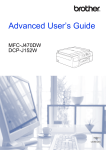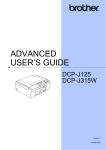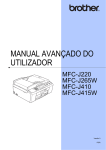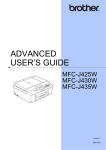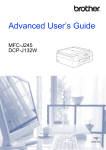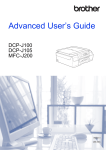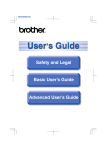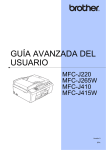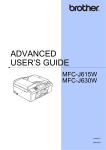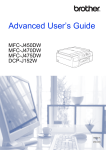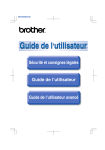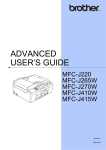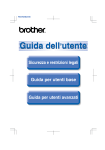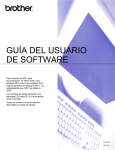Download Brother MFC-J410 User`s guide
Transcript
ADVANCED USER’S GUIDE MFC-J220 MFC-J265W MFC-J410 MFC-J415W Version 0 UK/IRE/GEN Downloaded from ManualsPrinter.com Manuals User's Guides and where do I find it? Which manual? What's in it? Where is it? Safety and Legal Please read the Safety Instructions before you set up your machine. Printed / In the box Quick Setup Guide Read this Guide first. Follow the instructions for setting up your machine and installing the drivers and software for the operating system and connection type you are using. Printed / In the box Basic User's Guide Learn the basic Fax, Copy, Scan and PhotoCapture Center™ operations and how to replace consumables. See troubleshooting tips. Printed / In the box Advanced User's Guide Learn more advanced operations: Fax, Copy, security features, printing reports and performing routine maintenance. PDF file / Documentation CD-ROM Software User's Guide Follow these instructions for Printing, Scanning, Network Scanning (MFC-J265W and MFC-J415W only), PhotoCapture Center™, PC-Fax Send, and using the Brother ControlCenter utility. PDF file / Documentation CD-ROM Network User's Guide (MFC-J265W and MFC-J415W only) This Guide provides more advanced information for configuring the Wireless network connections. In addition, find information about network utilities, network printing, troubleshooting tips and supported network specifications. PDF file / Documentation CD-ROM i Downloaded from ManualsPrinter.com Manuals Table of Contents 1 General setup 1 Memory storage.....................................................................................................1 Automatic Daylight Saving Time............................................................................1 Sleep Mode ...........................................................................................................2 LCD display ...........................................................................................................2 LCD Contrast...................................................................................................2 Setting the Dim Timer for the backlight ..........................................................3 Mode Timer............................................................................................................3 2 Security features 4 TX Lock .................................................................................................................4 Setting and changing the TX Lock password ..................................................4 Turning TX Lock on/off ....................................................................................5 3 Sending a fax 6 Additional sending options.....................................................................................6 Sending faxes using multiple settings .............................................................6 Contrast ...........................................................................................................6 Changing fax resolution...................................................................................7 Setting your changes as a new default............................................................7 Restoring fax settings to the factory settings...................................................7 Additional sending operations................................................................................8 Sending a fax manually ...................................................................................8 Dual Access (Monochrome only).....................................................................8 Broadcasting (Monochrome only)....................................................................8 Real Time Transmission................................................................................ 10 Overseas Mode .............................................................................................10 Checking and cancelling waiting jobs ............................................................11 4 Receiving a fax 12 Additional receiving operations............................................................................12 Printing a reduced incoming fax .................................................................... 12 Out of Paper Reception .................................................................................12 5 Dialling and storing numbers 13 Voice operations .................................................................................................. 13 BT Call Sign (U.K. only).................................................................................13 Additional dialling operations ...............................................................................14 Combining Quick Dial numbers ..................................................................... 14 Additional ways to store numbers........................................................................15 Storing Speed Dial numbers from Outgoing Calls ......................................... 15 Storing Speed Dial numbers from the Caller ID history................................. 15 Setting up groups for broadcasting................................................................ 16 ii Downloaded from ManualsPrinter.com Manuals 6 Printing reports 18 Fax reports...........................................................................................................18 Transmission Verification Report...................................................................18 Fax Journal (activity report) ...........................................................................18 Reports ................................................................................................................19 How to print a report ......................................................................................19 7 Making copies 20 Copy settings .......................................................................................................20 Stop copying..................................................................................................20 Changing copy speed and quality .................................................................20 Enlarging or reducing the copied image ........................................................21 Making N in 1 copies or a poster (Page Layout) ..........................................22 Sorting copies using the ADF (MFC-J410 and MFC-J415W only) ................23 Adjusting Density ...........................................................................................24 Setting your changes as a new default..........................................................24 Restoring all settings to the factory settings ..................................................24 8 Printing photos from a memory card 25 PhotoCapture Center™ operations .....................................................................25 Memory cards folder structures .....................................................................25 Print Images.........................................................................................................26 Print Index (Thumbnails) ...............................................................................26 Printing Photos ..............................................................................................27 Print All Photos ..............................................................................................27 DPOF printing ................................................................................................28 PhotoCapture Center™ print settings..................................................................28 Print Quality ...................................................................................................29 Paper options ................................................................................................29 Adjusting Brightness, Contrast and Colour....................................................30 Cropping ........................................................................................................30 Borderless printing.........................................................................................31 Date Print.......................................................................................................31 Setting your changes as a new default..........................................................31 Restoring all settings to the factory settings ..................................................31 Scan to a memory card........................................................................................32 How to set a new default ...............................................................................32 How to reset to factory settings .....................................................................32 iii Downloaded from ManualsPrinter.com Manuals A Routine maintenance 33 Cleaning and checking the machine.................................................................... 33 Cleaning the outside of the machine ............................................................. 33 Cleaning the machine’s printer platen ........................................................... 34 Checking the ink volume ...............................................................................34 Packing and shipping the machine ...................................................................... 35 B Glossary 38 C Index 42 iv Downloaded from ManualsPrinter.com Manuals v Downloaded from ManualsPrinter.com Manuals 1 General setup Memory storage Even if there is a power failure, you will not lose the settings you have chosen using the Menu key because they are stored permanently. Also, you will not lose your settings in the FAX, COPY and PHOTO CAPTURE mode key menus if you have chosen Set New Default. You may have to reset the date and time. 1 1 1 Automatic Daylight Saving Time 1 You can set the machine to change automatically for daylight saving time. It will reset itself forward one hour in the Spring and backward one hour in the Autumn. Make sure you have set the correct date and time in the Date&Time setting. a b Press Menu. c Press a or b to choose Auto Daylight. Press OK. d Press a or b to choose Off (or On). Press OK. e Press Stop/Exit. Press a or b to choose General Setup. Press OK. 1 Downloaded from ManualsPrinter.com Manuals Chapter 1 Sleep Mode You can choose how long the machine will remain idle (from 1 to 60 minutes) before it goes into sleep mode. The timer will restart if any operation is carried out on the machine. a b Press Menu. Press a or b to choose General Setup. Press OK. c Press a or b to choose Sleep Mode. Press OK. d Press a or b to choose 1Min, 2Mins, 3Mins, 5Mins, 10Mins, 30Mins or 60Mins. Press OK. e Press Stop/Exit. 2 Downloaded from ManualsPrinter.com Manuals 1 LCD display LCD Contrast 1 1 You can adjust the LCD contrast for a sharper and more vivid display. If you are having difficulty reading the LCD, try changing the contrast setting. a b Press Menu. c Press a or b to choose LCD Settings. Press OK. d Press a or b to choose LCD Contrast. Press OK. e Press d or c to change lighter or darker. Press OK. f Press Stop/Exit. Press a or b to choose General Setup. Press OK. General setup Setting the Dim Timer for the backlight Mode Timer 1 1 You can set how long the LCD backlight stays on after the last key press. a b Press Menu. c Press a or b to choose LCD Settings. Press OK. d Press a or b to choose Dim Timer. Press OK. e Press a or b to choose 10Secs, 20Secs, 30Secs or Off. Press OK. f Press Stop/Exit. Press a or b to choose General Setup. Press OK. The machine has four temporary mode keys on the control panel: FAX, SCAN, COPY and PHOTO CAPTURE. You can change the amount of time the machine takes after the last Scan, Copy or PhotoCapture operation before it returns to Fax mode. If you choose Off, the machine stays in the mode you used last. a b Press Menu. c Press a or b to choose Mode Timer. Press OK. d Press a or b to choose 0Sec, 30Secs, 1Min, 2Mins, 5Mins or Off. Press OK. e Press Stop/Exit. Press a or b to choose General Setup. Press OK. 3 Downloaded from ManualsPrinter.com Manuals 1 2 Security features TX Lock 2 TX Lock lets you prevent unauthorized access to the machine. While TX Lock is On, the following operations are available: Setting and changing the TX Lock password 2 2 Note If you have already set the password, you will not need to set it again. Receiving faxes While TX Lock is On, the following operations are NOT available: Sending faxes Copying Setting the password a b Press Menu. c Press a or b to choose Miscellaneous. Press OK. d Press a or b to choose TX Lock. Press OK. e Enter a 4-digit number for the password. Press OK. f When the LCD shows Verify:, re-enter the password. Press OK. g Press Stop/Exit. PC printing Scanning PhotoCapture Operation from the Control panel Note If you forget the TX Lock password, please call your Brother dealer for service. 4 Downloaded from ManualsPrinter.com Manuals 2 Press a or b to choose Fax. Press OK. Security features Changing the password a b 2 Turning TX Lock on/off 2 Press Menu. Press a or b to choose Fax. Press OK. Turning TX Lock on a b Press Menu. c Press a or b to choose Miscellaneous. Press OK. 2 2 c Press a or b to choose Miscellaneous. Press OK. d Press a or b to choose TX Lock. Press OK. e Press a or b to choose Set Password. Press OK. d Press a or b to choose TX Lock. Press OK. f Enter a 4-digit number for the current password. Press OK. e Press a or b to choose Set TX Lock. Press OK. g Enter a 4-digit number for a new password. Press OK. f Enter the registered 4-digit password. Press OK. The machine goes offline and the LCD shows TX Lock Mode. h When the LCD shows Verify:, re-enter the password. Press OK. i Press Stop/Exit. Press a or b to choose Fax. Press OK. Turning TX Lock off a b 2 Press Menu. Enter the registered 4-digit password. Press OK. TX Lock is automatically turned off. Note If you enter the wrong password, the LCD shows Wrong Password and stays offline. The machine will stay in TX Lock mode until the registered password is entered. 5 Downloaded from ManualsPrinter.com Manuals 3 Sending a fax Additional sending options 3 Contrast 3 When you send a fax you can choose any combination of these settings: resolution, contrast, scan size etc. If your document is very light or very dark, you may want to change the contrast. For most documents the factory setting Auto can be used. It automatically chooses the suitable contrast for your document. Choose Light when sending a light document. Choose Dark when sending a dark document. a a Press b Press a or b to choose Contrast. Press OK. c Press a or b to choose Auto, Light or Dark. Press OK. Sending faxes using multiple settings Press (FAX). The LCD shows: 3 3 Press Start Enter Number Fax Resolution Standard Contrast b Press a or b to choose a setting you want to change. Press OK. c Press a or b to choose an option. Press OK. d Go back to b to change more settings. Note • Most settings are temporary and the machine returns to its default settings after you send a fax. • You can save some of the settings you use most often by setting them as default. These settings will stay until you change them again. (See Setting your changes as a new default on page 7.) 6 Downloaded from ManualsPrinter.com Manuals (FAX). Note Even if you choose Light or Dark, the machine will send the fax using the Auto setting in any of the following conditions: • When you send a colour fax. • When you choose Photo as the Fax Resolution. Sending a fax Changing fax resolution The quality of a fax can be improved by changing the fax resolution. a Press b Press a or b to choose Fax Resolution. Press OK. c Press a or b to choose the resolution you want. Press OK. (FAX). 3 Setting your changes as a new default You can save the fax settings for Fax Resolution, Contrast, Real Time TX and Glass ScanSize you use most often by setting them as default. These settings will stay until you change them again. a Press b Press a or b to choose the menu option that you want to change and press OK. Then press a or b to choose the new option. Press OK. Note You can choose four different resolution settings for monochrome faxes and two for colour. Monochrome Standard Suitable for most typed documents. Fine Good for small print and transmits a little slower than Standard resolution. S.Fine Good for small print or artwork and transmits slower than Fine resolution. Photo Use when the document has varying shades of grey or is a photograph. Photo has the slowest transmission. Colour Standard Suitable for most typed documents. Fine Use when the document is a photograph. The transmission time is slower than Standard resolution. If you choose S.Fine or Photo and then use the Colour Start key to send a fax, the machine will send the fax using the Fine setting. 3 3 (FAX). Repeat this step for each setting you want to change. c After changing the last setting, press a or b to choose Set New Default. Press OK. d e Press 1 to choose Yes. Press Stop/Exit. Restoring fax settings to the factory settings 3 You can restore the fax settings Fax Resolution, Contrast, Real Time TX, and Glass ScanSize, that you have changed, to the factory settings. a Press b Press a or b to choose Factory Reset. Press OK. c d Press 1 to choose Yes. (FAX). Press Stop/Exit. 7 Downloaded from ManualsPrinter.com Manuals Chapter 3 Additional sending operations Sending a fax manually Dual Access (Monochrome only) 3 Manual transmission lets you hear the dialling, ringing and fax-receiving tones while sending a fax. Note You can dial a number and start scanning the fax into memory—even when the machine is sending from memory, receiving faxes or printing PC data. The LCD shows the new job number and available memory. The number of pages you can scan into the memory will vary depending on the data that is printed on them. (MFC-J410 and MFC-J415W only) To send a multiple page fax, use the ADF. a Press b c Load your document. d e f (FAX). To listen for a dial tone pick up the handset of the external telephone. Dial the fax number. When you hear the fax tone, press Mono Start or Colour Start. If you are using the scanner glass press 1 on the machine to send a fax. Replace the handset. 8 Downloaded from ManualsPrinter.com Manuals 3 3 Note If the Out of Memory message appears, press Stop/Exit to cancel or Mono Start to send the pages scanned so far. Broadcasting (Monochrome only) 3 Broadcasting is when the same fax message is automatically sent to more than one fax number. You can include Groups, Speed Dial numbers, and up to 50 manually dialled numbers in the same broadcast. After the broadcast is finished, a Broadcast Report will be printed. a Press b c Load your document. (FAX). Press a or b to choose Broadcasting. Press OK. Sending a fax d You can add numbers to the broadcast in the following ways: Press a or b to choose Add Number and press OK. Enter a number using dial pad. Press OK. Press a or b to choose Speed Dial and OK. Press a or b to choose Alphabetical Order or Numerical Order and OK. Press a or b to select a number and OK. e After you have entered all the fax numbers by repeating step d, press a or b to choose Complete. Press OK. f Press Mono Start. Cancelling a Broadcast in progress a b Press Menu. c Press a or b to choose Remaining Jobs. Press OK. The LCD will show the fax number being dialled and the Broadcast job number. • The available memory will vary depending on the types of jobs in the memory and the number of locations used for broadcasting. If you broadcast to the maximum numbers available, you will not be able to use dual access. • If the Out of Memory message appears, press Stop/Exit to cancel or Mono Start to send the pages scanned so far. Press a or b to choose Fax. Press OK. d Press OK. The LCD will ask you the following question: Cancel Job? Yes i Press 1 No i Press 2 e Press 1 to cancel the fax number being dialled. The LCD will then show the Broadcast job number. f Press OK. The LCD will ask you the following question: Cancel Job? Yes i Press 1 No i Press 2 g h To cancel the Broadcast, press 1. Note • If you did not use up any of the numbers for Groups, you can “broadcast” faxes to as many as 90 different numbers. 3 Press Stop/Exit. 9 Downloaded from ManualsPrinter.com Manuals 3 Chapter 3 Real Time Transmission 3 When you are sending a fax, the machine will scan the documents into the memory before sending. Then, as soon as the telephone line is free, the machine will start dialling and sending. Sometimes, you may want to send an important document immediately, without waiting for memory transmission. You can do this by turning on Real Time TX. a Press b Press a or b to choose Real Time TX. Press OK. c Press a or b to choose On (or Off). Press OK. (FAX). Note • (MFC-J410 and MFC-J415W only) If the memory is full and you are sending a black & white fax from the ADF, the machine will send the document in real time (even if Real Time TX is set to Off). Faxes from the scanner glass cannot be sent until you clear some of the memory. • In Real Time Transmission, the automatic redial feature does not work when using the scanner glass. 10 Downloaded from ManualsPrinter.com Manuals Overseas Mode If you are having difficulty sending a fax overseas due to possible interference on the telephone line, we recommend that you turn on the Overseas mode. After you send a fax using this feature, the feature will turn itself off. a Press b c Load your document. d Press a or b to choose On (or Off). Press OK. (FAX). Press a or b to choose Overseas Mode. Press OK. 3 Sending a fax Checking and cancelling waiting jobs 3 You can check which jobs are still waiting in the memory to be sent, or cancel a job. (If there are no jobs, the LCD shows No Jobs Waiting.) a b Press Menu. c Press a or b to choose Remaining Jobs. Press OK. Any waiting jobs appear on the LCD. d Press a or b to scroll through the jobs and choose the job you want to cancel. Press OK. e Do one of the following: 3 Press a or b to choose Fax. Press OK. To cancel, press 1 to choose Yes. If you want to cancel another job go to step d. To exit without cancelling, press 2 to choose No. f When you have finished, press Stop/Exit. 11 Downloaded from ManualsPrinter.com Manuals 4 Receiving a fax Additional receiving operations Printing a reduced incoming fax If you choose On, the machine automatically reduces each page of an incoming fax to fit on one page of A4, Letter or Legal size paper. The machine calculates the reduction ratio by using the page size of the fax and your Paper Size setting. (See Paper Size in chapter 2 in the Basic User’s Guide.) a b Press Menu. c Press a or b to choose Setup Receive. Press OK. d Press a or b to choose Auto Reduction. Press OK. e Press a or b to choose On (or Off). Press OK. f Press Stop/Exit. Press a or b to choose Fax. Press OK. 12 Downloaded from ManualsPrinter.com Manuals Out of Paper Reception 4 4 As soon as the paper tray becomes empty during fax reception, the LCD shows No Paper Fed. Put some paper in the paper tray. (See Loading paper and other print media in chapter 2 in the Basic User’s Guide.) The machine will carry on receiving the fax, with the remaining pages being stored in memory, if enough memory is available. Further incoming faxes will also be stored in memory until the memory is full. When the memory is full the machine will stop automatically answering calls. To print the faxes, put fresh paper in the tray. 4 4 5 Dialling and storing numbers Voice operations 5 Voice calls can be made either with an extension or external telephone, by dialling manually, or by using Quick Dial numbers. BT Call Sign (U.K. only) Your machine has a BT Call Sign compatible distinctive ringing function, allowing you to dedicate a second telephone number (on the same telephone line) just for receiving faxes. Note • You can switch BT Call Sign off temporarily, then turn it back on. When you get a new fax number, make sure you reset this function. This machine will automatically answer incoming calls that use your new fax number. To enable the machine to work with BT Call Sign (with your external telephone only) a b Press Menu. c Press a or b to choose Miscellaneous. Press OK. 5 This machine feature lets you use the BT Call Sign subscriber service which allows you to have at least two separate telephone numbers on one telephone line. Each telephone number has its own distinctive ringing pattern, so you know which telephone number is ringing. This is one way you can have a separate telephone number for your machine. 5 5 Press a or b to choose Fax. Press OK. 5 d Press a or b to choose BT Call Sign. Press OK. e Press a or b to choose On (or Off). Press OK. f Press Stop/Exit. Note If you turn off BT Call Sign, the receive mode stays in Manual. You will need to set receive mode again. (See Choose the Receive Mode in chapter 5 in the Basic User’s Guide.) • When you set the BT Call Sign feature to On, the receive mode is set to Manual automatically. Manual mode will not respond to incoming telephone calls, since the number you use for telephone calls will use the normal ring pattern. 13 Downloaded from ManualsPrinter.com Manuals Chapter 5 Additional dialling operations Combining Quick Dial numbers g 5 5 Sometimes, you may want to choose from several long distance carriers when you send a fax. Rates may vary depending on the time and destination. To take advantage of low rates, you can store the access codes of longdistance carriers and credit card numbers as Speed Dial numbers. You can store these long dialling sequences by dividing them and setting them up as separate Speed Dial numbers in any combination. You can even include manual dialling using the dial pad. (See Storing Speed Dial numbers in chapter 7 in the Basic User’s Guide.) For example, you might have stored “555“ on Speed Dial: 03 and “7000“ on Speed Dial: 02. You can use them both to dial “555-7000” if you press the following keys: a Press b Press a or b to choose Search. Press OK. c d Enter 03. e Press a or b to choose Search. Press OK. f Enter 02. (Speed Dial). Press a or b to choose Speed Dial. Press OK. 14 Downloaded from ManualsPrinter.com Manuals Press Mono Start or Colour Start. You will dial “555-7000”. To temporarily change a number, you can substitute part of the number with manual dialling using the dial pad. For example, to change the number to 555-7001 you could press (Speed Dial), choose Search, press 03 and then press 7001 using the dial pad. Note If you must wait for another dial tone or signal at any point in the dialling sequence, create a pause in the number by pressing Redial/Pause. Each key press adds a 3.5-second delay. Dialling and storing numbers Additional ways to store numbers Storing Speed Dial numbers from Outgoing Calls You can also store Speed Dial numbers from the Outgoing Call history. a Press Redial/Pause. You can also choose Outgoing Call by pressing (FAX). Storing Speed Dial numbers from the Caller ID history 5 5 5 If you have the Caller ID subscriber service from your telephone company you can also store Speed Dial numbers from incoming calls in the Caller ID History. (See Caller ID (U.K. and Ireland only) in chapter 6 in the Basic User’s Guide.) a Press Redial/Pause and press l. You can also choose Caller ID hist. by pressing (FAX). 5 b Press a or b to choose the name or number you want to store. Press OK. b Press a or b to choose the number you want to store. Press OK. c Press a or b to choose Add to Speed Dial. Press OK. c Press a or b to choose Add to Speed Dial. Press OK. d Press a or b to choose the 2-digit Speed Dial location where you want to store the number. Press OK. d Press a or b to choose the 2-digit Speed Dial location where you want to store the number. Press OK. e Do one of the following: e Do one of the following: Enter the name (up to 16 characters) using the dial pad. Press OK. (To help you enter letters, see Entering Text in appendix C in the Basic User’s Guide.) Enter the name (up to 16 characters) using the dial pad. Press OK. (To help you enter letters, see Entering Text in appendix C in the Basic User’s Guide.) To store the number without a name, press OK. To store the number without a name, press OK. f Press OK to confirm the fax or telephone number. f Press OK to confirm the fax or telephone number. g Press a or b to choose Complete. Press OK. g Press a or b to choose Complete. Press OK. h Press Stop/Exit. h Press Stop/Exit. 15 Downloaded from ManualsPrinter.com Manuals Chapter 5 Setting up groups for broadcasting g To add another number to the group, repeat steps e to f. 5 Groups, which can be stored in a Speed Dial location, allow you to send the same fax message to many fax numbers by pressing only (Speed Dial), Search, OK, the two-digit location and Mono Start. First, you'll need to store each fax number in a Speed Dial location. Then you can include them as numbers in the Group. Each Group uses up a Speed Dial location. You can have up to six Groups, or you can assign up to 39 numbers in a large Group. (See Broadcasting (Monochrome only) on page 8 and Storing Speed Dial numbers in chapter 7 in the Basic User’s Guide.) a Press b Press a or b to choose Setup Groups. Press OK. c Press a or b to choose GROUP1, GROUP2, GROUP3, GROUP4, GROUP5 or GROUP6 for the Group name where you will store the fax numbers. Press OK. d Press a or b to choose the 2-digit Speed Dial location where you want to store the Group. Press OK. e Press a or b to choose Add Number. Press OK. f To add numbers to the group, press a or b to choose Alphabetical Order or Numerical Order and OK. Press a or b to select a number and OK. (Speed Dial). 16 Downloaded from ManualsPrinter.com Manuals Do one of the following: If you are finished adding numbers to the group, press a or b to choose Complete. Press OK. h Do one of the following: To store another Group for broadcasting, repeat steps c to g. To finish storing Groups for broadcasting, press Stop/Exit. Note You can print a list of all the Speed Dial numbers. Group numbers will be marked in the GROUP column. (See Reports on page 19.) Dialling and storing numbers Changing a Group name a Press b 5 Deleting a Group 5 a Press Press a or b to choose Setup Groups. Press OK. b Press a or b to choose Setup Groups. Press OK. c Press a or b to choose the Group name you want to change. Press OK. c Press a or b to choose the Group you want to delete. Press OK. d Press a or b to choose Change Group Name. Press OK. d Press a or b to choose Delete. Press OK. Press 1 to confirm. Note e (Speed Dial). How to change the stored name or number: If you want to change a character, press d or c to position the cursor under the character you want to change, and then press Clear. Re-enter the character. e Enter the new name (up to 16 characters) using the dial pad. Press OK. (See Entering Text in appendix C in the Basic User’s Guide. For example, type NEW CLIENTS.) f Press a or b to choose Complete. Press OK. g Press Stop/Exit. (Speed Dial). 5 Press Stop/Exit. Deleting a number from a Group 5 a Press b Press a or b to choose Setup Groups. Press OK. c Press a or b to choose the Group you want to change. Press OK. d Press a or b to choose the number you want to delete. Press OK. Press 1 to confirm. e Press a or b to choose Complete. Press OK. f Press Stop/Exit. (Speed Dial). 17 Downloaded from ManualsPrinter.com Manuals 6 Printing reports Fax reports e 6 You need to set up the Transmission Verification Report and Journal Period using the Menu keys. Transmission Verification Report You can set the machine to print a journal at specific intervals (every 50 faxes, 6, 12 or 24 hours, 2 or 7 days). If you set the interval to Off, you can still print the report by following the steps in How to print a report on page 19. The factory setting is Every 50 Faxes. a b Press Menu. Press a or b to choose Fax. Press OK. c Press a or b to choose Report Setting. Press OK. d Press a or b to choose Journal Period. Press OK. 18 Downloaded from ManualsPrinter.com Manuals Press a or b to choose an interval. Press OK. If you choose Every 50 Faxes, go to step h. 6, 12, 24 hours, 2 or 7 days The machine will print the report at the chosen time and then erase all jobs from its memory. If the machine's memory is filled with the maximum 200 jobs before the time you chose has passed, the machine will print the Journal early and then erase all jobs from the memory. If you want an extra report before it is due to print, you can print it without erasing the jobs from the memory. 6 You can use the Transmission Verification Report as proof that you sent a fax. (For details about how to set up the type of report you want, see Transmission Verification Report in chapter 4 in the Basic User’s Guide.) Fax Journal (activity report) 6 Every 50 Faxes 6 The machine will print the Journal when the machine has stored 50 jobs. f Enter the time to start printing in 24-hour format. Press OK. (For example: enter 19:45 for 7:45 PM.) g If you choose Every 7 Days, the LCD will ask you to choose the first day for the 7-day countdown. h Press Stop/Exit. Printing reports Reports The following reports are available: XMIT Verify Prints a Transmission Verification Report for your last transmission. Help List A help list showing how to program your machine. Quick Dial Lists names and numbers stored in the Speed Dial memory, in alphabetical or numerical order. Fax Journal Lists information about the last incoming and outgoing faxes. (TX: Transmit.) (RX: Receive.) 6 How to print a report 6 a b Press Menu. c Press a or b to choose the report you want. Press OK. d (Quick Dial only) Press a or b to choose Alphabetical Order or Numerical Order. Press OK. e f Press Mono Start. Press a or b to choose Print Reports. Press OK. 6 Press Stop/Exit. User Settings Lists your settings. Network Config (MFC-J265W and MFC-J415W only) Lists your Network settings. WLAN Report (MFC-J265W and MFC-J415W only) Prints a WLAN connection report. Caller ID hist. Lists the available Caller ID information about the last 30 received faxes and telephone calls. 19 Downloaded from ManualsPrinter.com Manuals 7 Making copies Copy settings 7 You can change the copy settings temporarily for multiple copies. Fast Fast copy speed and lowest amount of ink used. Use to save time printing documents to be proof-read, large documents or many copies. To change a setting, press COPY and then press a or b to scroll through the copy settings. When the setting you want is highlighted, press OK. Normal Normal is the recommended mode for ordinary print outs. This produces good copy quality with good copy speed. When you are finished choosing settings, press Mono Start or Colour Start. Best Note You can save some of the settings that you use most often by setting them as default. These settings will stay until you change them again. (See Setting your changes as a new default on page 24.) To stop copying, press Stop/Exit. 20 Downloaded from ManualsPrinter.com Manuals Changing copy speed and quality You can choose from a range of speed and quality. The factory setting is Normal. The machine returns to its default settings after 1 minute, or if the Mode Timer returns the machine to Fax mode. (See Mode Timer on page 3.) Stop copying 7 Use Best mode to copy precise images such as photographs. This provides the highest resolution and slowest speed. 7 a Press b c d Load your document. e Press a or b to choose Fast, Normal or Best. Press OK. f If you do not want to change additional settings, press Mono Start or Colour Start. (COPY). Enter the number of copies you want. Press a or b to choose Quality. Press OK. 7 Making copies Enlarging or reducing the copied image You can choose an enlargement or reduction ratio. If you choose Fit to Page, your machine will adjust the size automatically to the paper size you set. 198% 10x15cmiA4 7 186% 10x15cmiLTR 142% A5iA4 100% 97% LTRiA4 93% A4iLTR (MFC-J220 and MFC-J265W only) 83% a Press b c d Load your document. (MFC-J410 and MFC-J415W only) 83% LGLiA4 Enter the number of copies you want. 69% A4iA5 Press a or b to choose Enlarge/Reduce. Press OK. 47% A4i10x15cm (COPY). e Press a or b to choose 100%, Enlarge, Reduce, Fit to Page or Custom(25-400%). f Do one of the following: If you chose Enlarge or Reduce, press OK and press a or b to choose the enlargement or reduction ratio you want. Press OK. If you chose Custom(25-400%), press OK and then enter an enlargement or reduction ratio from 25% to 400%. Press OK. If you chose 100% or Fit to Page, press OK. Go to step g. Fit to Page Custom(25-400%) g If you do not want to change additional settings, press Mono Start or Colour Start. Note • Page Layout is not available with Enlarge/Reduce. • Page Layout and Sort (MFC-J410 and MFC-J415W only) are not available with Fit to Page. • Fit to Page does not work correctly when the document on the scanner glass is skewed more than 3 degrees. Using the document guidelines on the left and top, place your document in the upper left hand corner, with the document face down on the scanner glass. • Fit to Page is not available when using the ADF. 21 Downloaded from ManualsPrinter.com Manuals 7 Chapter 7 Making N in 1 copies or a poster (Page Layout) The N in 1 copy feature can help you save paper by letting you copy two or four pages onto one printed page. e Press a or b to choose Off(1in1), 2 in 1 (P), 2 in 1 (L), 4 in 1 (P), 4 in 1 (L) or Poster(3x3). Press OK. f If you do not want to change additional settings, press Mono Start or Colour Start to scan the page. If you placed the document in the ADF or are making a poster, the machine scans the document and starts printing. 7 You can also produce a poster. When you use the poster feature your machine divides your document into sections, then enlarges the sections so you can assemble them into a poster. If you want to print a poster, use the scanner glass. If you are using the scanner glass, go to step g. IMPORTANT • Make sure paper size is set to A4 or Letter. g After the machine scans the page, press 1 to scan the next page. • You cannot use the Enlarge/Reduce and Stack/Sort (MFC-J410 and MFC-J415W only) settings with the N in 1 and Poster features. h Place the next page on the scanner glass. Press OK. • N in 1 colour copies are not available. i Repeat steps g and h for each page of the layout. j After all the pages have been scanned, press 2 to finish. • (P) means Portrait and (L) means Landscape. • You can only make one poster copy at a time. Note Sort (MFC-J410 and MFC-J415W only) and Enlarge/Reduce are not available with Page Layout. a Press b c d Load your document. (COPY). Enter the number of copies you want. Press a or b to choose Page Layout. Press OK. 22 Downloaded from ManualsPrinter.com Manuals Note If you have chosen photo paper as the Paper Type for N in 1 copies, the machine will print the images as if plain paper had been chosen. Making copies Place the document face down in the direction shown below: 2 in 1 (P) Sorting copies using the ADF (MFC-J410 and MFC-J415W only) 7 You can sort multiple copies. Pages will be stacked in the order 321, 321, 321, and so on. 2 in 1 (L) 4 in 1 (P) 4 in 1 (L) Poster(3 x 3) You can make a poster size copy of a photograph. a Press b c d Load your document. e Press a or b to choose Sort. Press OK. f If you do not want to change additional settings, press Mono Start or Colour Start. (COPY). Enter the number of copies you want. Press a or b to choose Stack/Sort. Press OK. Note Fit to Page and Page Layout are not available with Sort. 23 Downloaded from ManualsPrinter.com Manuals 7 Chapter 7 Adjusting Density 7 You can adjust the copy density to make copies darker or lighter. a Press b c d Load your document. e Press d or c to make a lighter or darker copy. Press OK. f You can restore the copy settings Quality, Enlarge/Reduce, Density, and Page Layout, that you have changed, to the factory settings. (COPY). Enter the number of copies you want. Press a or b to choose Density. Press OK. If you do not want to change additional settings, press Mono Start or Colour Start. Setting your changes as a new default 7 You can save the copy settings for Quality, Enlarge/Reduce, Density and Page Layout that you use most often by setting them as the default settings. These settings will stay until you change them again. a Press b Press a or b to choose your new setting. Press OK. Repeat this step for each setting you want to change. c After changing the last setting, press a or b to choose Set New Default. Press OK. d e Press 1 to choose Yes. (COPY). Press Stop/Exit. 24 Downloaded from ManualsPrinter.com Manuals Restoring all settings to the factory settings a Press b Press a or b to choose Factory Reset. Press OK. c d Press 1 to choose Yes. (COPY). Press Stop/Exit. 7 8 Printing photos from a memory card PhotoCapture Center™ operations Memory cards folder structures Your machine is designed to be compatible with modern digital camera image files, memory cards; however, please read the points below to avoid errors: The image file extension must be .JPG (other image file extensions like .JPEG, .TIF, .GIF and so on will not be recognized). Direct PhotoCapture Center™ printing must be performed separately from PhotoCapture Center™ operations using the PC. (Simultaneous operation is not available.) The machine can read up to 999 files on a memory card. 8 Please be aware of the following: 8 8 When printing an index or image, the PhotoCapture Center™ will print all the valid images, even if one or more images have been corrupted. Corrupted images will not be printed. (memory card users) Your machine is designed to read memory cards that have been formatted by a digital camera. When a digital camera formats a memory card it creates a special folder into which it copies image data. If you need to modify the image data stored on a memory card with your PC, we recommend that you do not modify the folder structure created by the digital camera. When saving new or modified image files to the memory card we also recommend you use the same folder your digital camera uses. If the data is not saved to the same folder, the machine may not be able to read the file or print the image. The DPOF file on the memory cards must be in a valid DPOF format. (See DPOF printing on page 28.) 25 Downloaded from ManualsPrinter.com Manuals 8 Chapter 8 d Print Images Do one of the following: 8 Print Index (Thumbnails) Press a or b to choose Paper Type, and press OK and press a or b to choose the type of paper you are using, Plain Paper, Inkjet Paper, Brother BP71, Brother BP61 or Other Glossy. 8 The PhotoCapture Center™ assigns numbers for images (such as No.1, No.2, No.3, and so on). Press OK. Press a or b to choose Paper Size and press OK and press a or b to choose the paper size you are using, A4 or Letter. Press OK. The PhotoCapture Center™ uses these numbers to identify each picture. You can print a thumbnail page to show all the pictures on the memory card. Note Only file names that are 8 characters or less will be printed correctly on the index sheet. a Make sure you have put the memory card in the correct slot. Press (PHOTO CAPTURE). b Press a or b to choose Print Index. Press OK. c Press a or b to choose 6 IMGs/Line or 5 IMGs/Line. Press OK. 6 IMGs/Line 5 IMGs/Line Print time for 5 IMGs/Line will be slower than 6 IMGs/Line, but the quality is better. 26 Downloaded from ManualsPrinter.com Manuals If you do not want to change the paper settings, go to step e. e Press Colour Start to print. Printing photos from a memory card Printing Photos 8 Print All Photos 8 Before you can print an individual image, you have to know the image number. You can print all the photos on your memory card. a Make sure you have put the memory card in the correct slot. Press (PHOTO CAPTURE). a Make sure you have put the memory card in the correct slot. Press (PHOTO CAPTURE). b Print the Index. (See Print Index (Thumbnails) on page 26.) b c Press a or b to choose Print Photos. Press OK. Press a or b to choose Print All Photos. Press OK. c Enter the number of copies you want using the dial pad. d Do one of the following: d e Enter the image number that you want to print, from the thumbnails printed on the Index page. Press OK. Repeat step d until you have entered the image numbers that you want to print. Change the print settings. (See PhotoCapture Center™ print settings on page 28.) If you do not want to change any settings, press Colour Start to print. Note • You can enter the numbers at one time by using the l key for a comma or the # key for a hyphen. For example, Enter 1, l, 3, l, 6 to print images No.1, No.3 and No.6. Enter 1, #, 5 to print images No.1 to No.5. • You can enter up to 12 characters (including commas) for the image numbers you want to print. f After you have chosen the image numbers, press OK again. g Enter the number of copies you want using the dial pad. h Do one of the following: Change the print settings. (See PhotoCapture Center™ print settings on page 28.) If you do not want to change any settings, press Colour Start to print. 27 Downloaded from ManualsPrinter.com Manuals 8 Chapter 8 DPOF printing 8 DPOF stands for Digital Print Order Format. Major digital camera manufacturers (Canon Inc., Eastman Kodak Company, FUJIFILM Corporation, Panasonic Corporation and Sony Corporation) created this standard to make it easier to print images from a digital camera. If your digital camera supports DPOF printing, you will be able to choose on the digital camera display the images and number of copies you want to print. PhotoCapture Center™ print settings You can change the print settings temporarily. The machine returns to its default settings after 3 minutes, or if the Mode Timer returns the machine to Fax mode. (See Mode Timer on page 3.) Note You can save the print settings you use most often by setting them as the default. (See Setting your changes as a new default on page 31.) When a memory card containing DPOF information is put into your machine, you can print the chosen image easily. a b c Make sure you have put the memory card in the correct slot. Press (PHOTO CAPTURE). The machine will ask you if you want to use DPOF settings. Press Start Change the print settings. (See PhotoCapture Center™ print settings on page 28.) If you do not want to change any settings, press Colour Start to print. Note A DPOF File error can occur if the print order that was created on the camera has been corrupted. Delete and recreate the print order using your camera to correct this problem. For instructions on how to delete or recreate the print order, refer to your camera manufacturer's support website or accompanying documentation. 28 Downloaded from ManualsPrinter.com Manuals 1 Print Quality Photo Paper Type Paper Size Press 1 to choose Yes. Do one of the following: 001 1 No. of prints (For View Photo(s)) You can see the total number of photos that will be printed. (For Print All Photos, Print Photos) You can see the number of copies of each photo that will be printed. (For DPOF printing) This does not appear. 8 Printing photos from a memory card Print Quality a 8 Press a or b to choose Print Quality. Press OK. b Press a or b to choose Normal or Photo. Press OK. c If you do not want to change additional settings, press Colour Start to print. Paper options 8 Paper and print size a Press a or b to choose Paper Size. Press OK. b Press a or b to choose the paper size you are using, 10x15cm, 13x18cm, A4 or Letter. Press OK. c If you chose A4 or Letter, press a or b to choose the Print Size. Press OK. Example: Printed Position for A4 paper 1 Paper Type a Press a or b to choose Paper Type. Press OK. b Press a or b to choose the paper type you are using, Plain Paper, Inkjet Paper, Brother BP71, Brother BP61 or Other Glossy. Press OK. c 8 2 8 x 10cm 8 3 9 x 13cm 10 x 15cm 8 4 5 6 13 x 18cm 15 x 20cm Max. Size If you do not want to change additional settings, press Colour Start to print. d If you do not want to change additional settings, press Colour Start to print. 29 Downloaded from ManualsPrinter.com Manuals Chapter 8 Adjusting Brightness, Contrast and Colour Brightness a Press a or b to choose Brightness. Press OK. b Press d or c to make a darker or lighter print. Press OK. c Cropping 8 8 You can choose the contrast setting. Increasing the contrast will make an image look sharper and more vivid. a Press a or b to choose Contrast. Press OK. b Press d or c to change the contrast. Press OK. c If you do not want to change additional settings, press Colour Start to print. 30 Downloaded from ManualsPrinter.com Manuals If your photo is too long or wide to fit the available space on your chosen layout, part of the image will automatically be cropped. The factory setting is On. If you want to print the whole image, turn this setting to Off. When you set Cropping to Off, also set Borderless to Off. (See Borderless printing on page 31.) If you do not want to change additional settings, press Colour Start to print. Contrast 8 8 a Press a or b to choose Cropping. Press OK. b Press a or b to choose Off (or On). Press OK. c If you do not want to change additional settings, press Colour Start to print. Cropping: On Cropping: Off 8 8 Printing photos from a memory card Borderless printing 8 This feature expands the printable area to the edges of the paper. Printing time will be slightly slower. a Press a or b to choose Borderless. Press OK. b Press a or b to choose Off (or On). Press OK. c If you do not want to change additional settings, press Colour Start to print. Date Print You can print the date if it is already in the data on your photo. The date will be printed on the lower right corner. If the data doesn’t have the date information, you cannot use this function. a Press a or b to choose Date Print. Press OK. b Press a or b to choose On (or Off). Press OK. c If you do not want to change additional settings, press Colour Start to print. Setting your changes as a new default 8 You can save the print settings you use most often by setting them as the default settings. These settings will stay until you change them again. a Press a or b to choose your new setting. Press OK. Repeat this step for each setting you want to change. b After changing the last setting, press a or b to choose Set New Default. Press OK. c d Press 1 to choose Yes. 8 Press Stop/Exit. Restoring all settings to the factory settings 8 8 You can restore the PhotoCapture settings Print Quality, Paper Type, Paper Size, Brightness, Contrast, Cropping, Borderless, and Date Print, that you have changed, to the factory settings. a Press a or b to choose Factory Reset. Press OK. b c Press 1 to choose Yes. Press Stop/Exit. 31 Downloaded from ManualsPrinter.com Manuals Chapter 8 Scan to a memory card How to set a new default 8 8 You can save the Scan to Media settings (Quality and File Type) you use most often by setting them as the default settings. These settings will stay until you change them again. a Press b Press a or b to choose Scan to Media. Press OK. c Press a or b to choose Set New Default. Press OK and 1 to choose Yes. d Press Stop/Exit. (SCAN). How to reset to factory settings You can restore all the Scan to Media settings (Quality and File Type), that you have changed, to the factory settings. a Press b Press a or b to choose Scan to Media. Press OK. c Press a or b to choose Factory Reset. Press OK and 1 to choose Yes. d Press Stop/Exit. (SCAN). 32 Downloaded from ManualsPrinter.com Manuals 8 A Routine maintenance Cleaning and checking the machine Cleaning the outside of the machine A b Wipe the outside of the machine with a dry, lint-free soft cloth to remove dust. c Lift the output paper tray cover and remove anything that is stuck inside the paper tray. d Wipe the paper tray with a dry, lint-free soft cloth to remove dust. A A IMPORTANT • Use neutral detergents. Cleaning with volatile liquids such as thinner or benzine will damage the outside surface of the machine. • DO NOT use cleaning materials that contain ammonia. • DO NOT use isopropyl alcohol to remove dirt from the control panel. It may crack the panel. Clean the outside of the machine as follows: a A A Pull the paper tray (1) completely out of the machine. 1 e Close the output paper tray cover and put the output paper tray firmly back in the machine. 33 Downloaded from ManualsPrinter.com Manuals Cleaning the machine’s printer platen CAUTION Be sure to unplug the machine from the electrical socket before cleaning the printer platen. a b Lift the scanner cover until it locks securely in the open position. Clean the machine’s printer platen (1) and the area around it, wiping off any scattered ink with a dry, soft lint-free cloth. Checking the ink volume A Although an ink volume icon appears on the LCD, you can use the Menu key to see a large graph showing the ink that is left in each cartridge. a b Press Menu. c Press a or b to choose Ink Volume. Press OK. The LCD shows the ink volume. d Press Stop/Exit. Press a or b to choose Ink Management. Press OK. Note You can check the ink volume from your computer. (See Printing for Windows® or Printing and Faxing for Macintosh in the Software User’s Guide.) 1 34 Downloaded from ManualsPrinter.com Manuals A Routine maintenance Packing and shipping the machine When you transport the machine, use the packing materials that came with your machine. Follow the instructions below to correctly pack your machine. Damage caused to your machine during transit is not covered by your warranty. IMPORTANT A • Make sure that the plastic tabs on both sides of the green protective part (1) have securely clicked into place (2). IMPORTANT It is important to allow the machine to “park” the print head after a print job. Listen carefully to the machine before unplugging it to make sure that all mechanical noise has stopped. Not allowing the machine to finish this parking process may lead to print problems and possible damage to the print head. a b Open the ink cartridge cover. c Install the green protective part and then close the ink cartridge cover. Remove all four ink cartridges. Press the ink release lever above each cartridge to release it. (See Replacing the ink cartridges in appendix A in the Basic User’s Guide.) 1 2 • If you are not able to find the green protective part, DO NOT remove the ink cartridges before shipping. It is essential that the machine be shipped with either the green protective part or the ink cartridges in position. Shipping without them will cause damage to your machine and may void your warranty. 35 Downloaded from ManualsPrinter.com Manuals A d Lift the machine from the front and hook the tab of the green protective part into the keyed opening (1) on the bottom of the paper tray. Then latch the protective part over the raised portion of the paper tray (2). h Lift the scanner cover ( ) to release the lock. Gently push the scanner cover support down ( ) and close the scanner cover ( ) using both hands. 1 2 3 2 i 1 e Unplug the machine from the telephone wall socket and take the telephone line cord out of the machine. f Unplug the machine from the electrical socket. g Using both hands, use the plastic tabs on both sides of the machine to lift the scanner cover until it locks securely into the open position. Then unplug the interface cable from the machine, if it is connected. 36 Downloaded from ManualsPrinter.com Manuals Wrap the machine in the bag. Routine maintenance j Pack the machine and the printed materials in the original carton with the original packing material as shown below. Do not pack the used ink cartridges in the carton. A k Close the carton and tape it shut. 37 Downloaded from ManualsPrinter.com Manuals B Glossary B This is a comprehensive list of features and terms that appear in Brother manuals. Availability of these features depends on the model you purchased. ADF (automatic document feeder) The document can be placed in the ADF and scanned one page at a time automatically. Auto Reduction Reduces the size of incoming faxes. Automatic fax transmission Sending a fax without picking up the handset of an external telephone. Automatic Redial A feature that enables your machine to redial the last fax number after five minutes if the fax did not go through because the line was busy. Beeper Volume Volume setting for the beep when you press a key or make an error. Brightness Changing the Brightness makes the whole image lighter or darker. Broadcasting The ability to send the same fax message to more than one location. Caller ID A service purchased from the telephone company that lets you see the number (or name) of the party calling you. CNG tones The special tones (beeps) sent by fax machines during automatic transmission to tell the receiving machine that a fax machine is calling. Coding method Method of coding the information contained in the document. All fax machines must use a minimum standard of Modified Huffman (MH). Your machine is capable of greater compression methods, Modified Read (MR), Modified Modified Read (MMR) and JPEG, if the receiving machine has the same capability. Communication error (Comm. Error) An error during fax sending or receiving, usually caused by line noise or static. Compatibility group The ability of one fax unit to communicate with another. Compatibility is assured between ITU-T Groups. Contrast Setting to compensate for dark or light documents, by making faxes or copies of dark documents lighter and light documents darker. Density Changing the Density makes the whole image lighter or darker. Dual Access Your machine can scan outgoing faxes or scheduled jobs into memory at the same time it is sending a fax from memory or receiving or printing an incoming fax. ECM (Error Correction Mode) Detects errors during fax transmission and resends the pages of the fax that had an error. Extension telephone A telephone using the same line as your fax but plugged into a separate wall socket. 38 Downloaded from ManualsPrinter.com Manuals Glossary External telephone A TAD (telephone answering device) or telephone that is connected to your machine. F/T Ring Time The length of time that the Brother machine rings (when the Receive Mode setting is Fax/Tel) to notify you to pick up a voice call that it answered. Fax Detect Enables your machine to respond to CNG tones if you interrupt a fax call by answering it. Fax Journal Lists information about the last 200 incoming and outgoing faxes. TX means Transmit. RX means Receive. Fax tones The signals sent by sending and receiving fax machines while communicating information. Fax/Tel You can receive faxes and telephone calls. Do not use this mode if you are using a telephone answering device (TAD). Fine resolution Resolution is 203 196 dpi. It is used for small print and graphs. Greyscale The shades of grey available for copying, scanning and faxing photographs. Group number A combination of Speed Dial numbers that are stored in a Speed Dial location for Broadcasting. Help list A printout of the complete Menu table that you can use to program your machine when you do not have the Basic User's Guide with you. Innobella™ Innobella™ is a range of genuine consumables offered by Brother. For best quality results Brother recommends Innobella™ Ink and Paper. Journal Period The pre-programmed time period between automatically printed Fax Journal Reports. You can print the Fax Journal on demand without interrupting the cycle. LCD (Liquid Crystal Display) The display screen on the machine that shows interactive messages during OnScreen Programming and shows the date and time when the machine is idle. Manual fax When you lift the handset of your external telephone you can hear the receiving fax machine answer before you press Mono Start or Colour Start to begin sending the fax. Menu mode Programming mode for changing your machine's settings. OCR (optical character recognition) ScanSoft™ PaperPort™11SE with OCR or Presto! PageManager software application converts an image of text to text you can edit. Overseas Mode Makes temporary changes to the fax tones to accommodate noise and static on overseas telephone lines. Pause Allows you to place a 3.5 second delay in the dialling sequence while you are dialling using the dial pad or while you are storing Speed Dial numbers. Press Redial/Pause as many times as needed for longer pauses. PhotoCapture Center™ Allows you to print digital photos from your digital camera at high resolution for photo quality printing. 39 Downloaded from ManualsPrinter.com Manuals B Photo resolution (Mono only) A resolution setting that uses varying shades of grey for the best representation of photographs. Pulse A form of rotary dialling on a telephone line. Quick Dial List A listing of names and numbers stored in Speed Dial memory, in numerical order. Real Time Transmission When memory is full, you can send faxes in real time. Remaining jobs You can check which jobs are waiting in memory and cancel jobs individually. Remote Activation Code Press this code (l 5 1) when you answer a fax call on an extension or external telephone. Remote Deactivation Code (For Fax/Tel mode only) When the machine answers a voice call, it pseudo/double-rings. You can pick up at an extension telephone by pressing this code (# 5 1). Resolution The number of vertical and horizontal lines per inch. See: Standard, Fine, Super Fine and Photo. Ring Delay The number of rings before the machine answers in Fax Only and Fax/Tel modes. Ring Volume Volume setting for the machine's ring. Scanning The process of sending an electronic image of a paper document into your computer. 40 Downloaded from ManualsPrinter.com Manuals Scan to Media You can scan a monochrome or colour document into a memory card. Monochrome images will be in TIFF or PDF file format and colour images may be in PDF or JPEG file format. Search An electronic, numerical or alphabetical listing of stored Speed Dial and Group numbers. Speed Dial A pre-programmed number for easy dialling. You must press (Speed Dial), OK, the two digit code, and Mono Start or Colour Start to start the dialling process. Standard resolution 203 97 dpi. It is used for regular size text and quickest transmission. Station ID The stored information that appears on the top of faxed pages. It includes the sender's name and fax number. Super Fine resolution (Mono only) 392 203 dpi. Best for very small print and line art. TAD (telephone answering device) You can connect an external TAD to your machine. Temporary settings You can choose certain options for each fax transmission and copy without changing the default settings. Tone A form of dialling on the telephone line used for touch-tone telephones. Transmission The process of sending faxes over the phone lines from your machine to the receiving fax machine. User Settings A printed report that shows the current settings of the machine. Glossary WLAN Report A printed report that shows the result of the WLAN Connection. Xmit Report (Transmission Verification Report) A listing for each fax sent, that shows its date, time and number. B 41 Downloaded from ManualsPrinter.com Manuals C Index A sending ................................................... 6 Broadcasting ....................................... 8 cancelling from memory .................... 11 contrast ............................................... 6 from memory (Dual Access) ................ 8 manual ................................................ 8 overseas ............................................ 10 Real Time Transmission .................... 10 Resolution ........................................... 7 return to factory setting ....................... 7 set new default .................................... 7 Access codes, storing and dialling ...........14 Apple Macintosh See Software User's Guide. B Broadcasting ..............................................8 setting up Groups for ............................16 C Caller ID Caller ID History report .........................19 Cancelling jobs awaiting redial ...............................11 Cleaning printer platen .........................................34 ControlCenter See Software User's Guide. Copy density ...................................................24 enlarge/reduce ......................................21 page layout (N in 1) ...............................22 quality ....................................................20 return to factory settings .......................24 set new default ......................................24 sort (ADF only) ......................................23 using ADF .............................................23 D Dialling Groups ....................................................8 Dual Access ...............................................8 F Fax, from PC See Software User's Guide. Fax, stand-alone receiving into the memory .................................12 out of paper reception ........................12 reducing to fit on paper ......................12 42 Downloaded from ManualsPrinter.com Manuals G Groups for Broadcasting ......................... 16 I Ink cartridges checking ink volume ............................. 34 L LCD (Liquid Crystal Display) Contrast .................................................. 2 Dim Timer ............................................... 3 Help List ............................................... 19 M Macintosh See Software User's Guide. Manual transmission ........................................... 8 Memory Storage ........................................ 1 Mode, entering Timer ...................................................... 3 N Network Printing See Network User's Guide. Scanning See Software User's Guide. P R Packing and shipping the machine ..........35 PaperPort™11SE with OCR See Software User's Guide. See also Help in the PaperPort™11SE application. PhotoCapture Center™ Borderless .............................................31 Cropping ...............................................30 DPOF printing .......................................28 from PC See Software User's Guide. Print settings Brightness ..........................................30 Contrast .............................................30 Date Print ...........................................31 Paper type & size ...............................29 Quality ......................................... 28, 29 Return to factory setting .....................31 Set new default ..................................31 Printing all photos ...........................................27 index ..................................................26 photos ................................................27 Scan to Media memory card ......................................32 Power failure ..............................................1 Presto! PageManager See Software User's Guide. See also Help in the Presto! PageManager application. Print report ....................................................19 Printing See Software User's Guide. Reducing copies ................................................... 21 incoming faxes ..................................... 12 Remote Setup See Software User's Guide. Reports .................................................... 18 Caller ID ............................................... 19 Caller ID History Report ....................... 19 Fax Journal .......................................... 19 Journal Period ................................... 18 Help List ............................................... 19 how to print ........................................... 19 Network Configuration .......................... 19 Quick Dial List ...................................... 19 Transmission Verification ............... 18, 19 User Settings ........................................ 19 Resolution setting for next fax .................................. 7 Q Quick Dial Broadcasting ...........................................8 using Groups .......................................8 Group dial changing ............................................17 setting up Groups for Broadcasting ...16 Speed Dial setting up from Caller ID history ........15 setting up from outgoing calls ............15 S Scanning See Software User's Guide. Shipping the machine .............................. 35 Sleep Mode ............................................... 2 Speed Dial storing .................................................. 15 T C Troubleshooting checking ink volume ............................. 34 TX Lock turning on/off .......................................... 5 W Windows® See Software User's Guide. Wireless Network See Quick Setup Guide and Network User's Guide. 43 Downloaded from ManualsPrinter.com Manuals Visit us on the World Wide Web http://www.brother.com This machine is approved for use in the country of purchase only. Local Brother companies or their dealers will only support machines purchased in their own countries. Downloaded from ManualsPrinter.com Manuals


















































